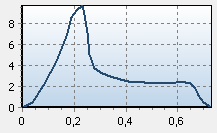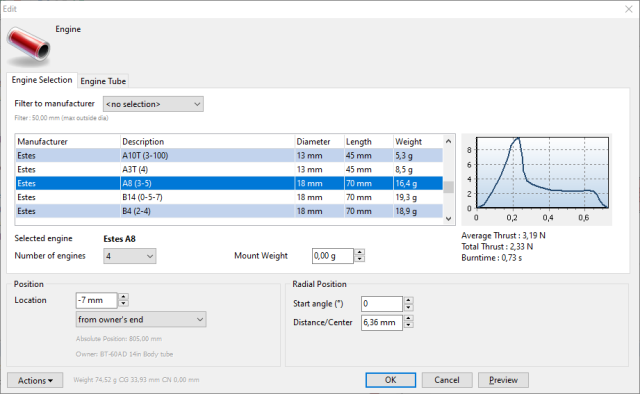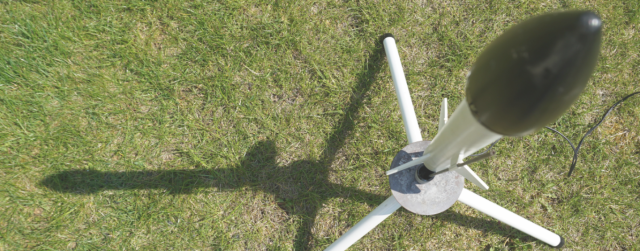Finally! Your rocket is built and standing on the launch pad, and the countdown starts.
5..4..3..2..1.. Zero - Launch! As your rocket climbs higher and higher you might wonder: how does this work? Why does my rocket fly, and how high will it fly?
In this blog post, I want to give you an overview on how a model rocket reaches its top altitude.
We all know that the engine gives the power so the rocket flies - but isn’t there more to it? Yes, there is.
The basics of flight prediction
Two forces (F) influence the model rocket: the engine that powers the model rocket to climb, and the atmosphere that drags the model rocket down plus the weight of the model rocket.
F total = F engine - (F weight + F air)
If F total is positive, the rocket climbs. The moment where F total becomes zero, the rocket’s acceleration
becomes zero, too (a = F/m). After that, negative accelerating forces will decrease the rocket’s velocity, until v=0.
That’s the point of equilibrium, the millisecond the rocket stands still in the air. After that it starts falling
and becomes faster and faster.
Parachute ejection
The point of equilibrium (or a little bit later) is the best place to eject the parachute: you don’t have to worry that it ejects too early (stopping the model rocket before it reaches the peak altitude), and you don’t have to worry that the rocket is already too fast, so that the parachute cord will break.
Perfect delay
SpaceCAD rocket design software refers to the time between engine burnout and the point of equilibrium as “perfect delay time”. This is usually a delay you won’t find in your engine box - at least I’ve never heard of an A8-2.62 - so it gives you an idea, which delay to choose (in this case, the A8-3 would do just fine).
Ignition - and lift-off!
So, what happens when you press the start button? The igniter in your rocket engine fires off and the propellant of the engine starts to burn. The stream of particles and heat leave the engine through its nozzle, powering the model rocket, hopefully straight up (see the article on rocket stability for more). It takes a couple of milliseconds before the engine has enough power to actually lift the model rocket.
The rocket engine (motor)

A model rocket engine is not working like a switch-on switch-off element; it rather has a typical thrust curve. A thrust curve describes the thrust a typical engine (say, an A8 engine) produces (see picture): At first, there is a peak which is typically twice as high as later, which kicks the model rocket from the launch pad. Then you can see a couple of milliseconds where the thrust does not change but remains on a pretty stable level.
This powers the rocket farther up in the sky, when the first difficult feet are left behind. And then - nothing. An engine really works only milliseconds. After that, it waits for the rocket to reach the altitude. This is called the coast phase. Model rocket engines usually produce smoke in that time (but no thrust), to ease following them on their way up. And then - bang! The ejection charge hits, and the parachute is pulled free from the body tube.
Thrust curve
In order to predict the flight of a model rocket, you need to know the thrust curve of the engine. This data is provided by the manufacturer or rocket organizations. An excellent source for engine data files is also the website thrustcurve.org, where you can download the latest engine files. The data is stored in a file ending with the “eng” extension. This is a standard format for model rocket software. These files can contain huge databases of engines, and each rocket engine is described in detail with the thrust curve.

How high does the model rocket fly?
So now you have a basic understanding of the forces of the model rocket, and the thrust curve of the engine. The question remains: how high does my rocket actually fly? Which is now easy to answer. The acceleration of any object can be described as
F = m * a
meaning the Force that powers it equals the mass times the acceleration. Or, the way we want it: a = F / m. The acceleration equals the (powering) Force (F total from above), divided by the mass of the model rocket. And once you have the acceleration, it’s easy to get to the velocity and the height, because they are simply derivations of the acceleration.
But wait: so far this has nothing to do with the time! What we want to know is how high the rocket will fly. So, what do we have to do? The answer is: iterate it! For every 0.1 seconds, compute the forces, the weight and get the altitude. The forces also change over time; because (a) the rocket becomes lighter (it loses the weight of the propellant) and (b) the drag forces depend on the speed of the rocket.
Coefficient of drag
An important number for the drag force is the coefficient of drag. This is a number that is very difficult to compute (for cars this value is typically measured in the wind tunnel). Model rocketeers usually stick to a value between 0.75 or 0.4. This depends on the rocket’s surface, tear off edges etc., causing the airflow to become turbulent.
Summary
I hope this article gives you a first impression how flight prediction works so that next time when you watch your rocket fly you know more about the relevant physics. Of course, this is a complex topic!

